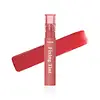What's inside
What's inside
 Key Ingredients
Key Ingredients

 Benefits
Benefits

 Concerns
Concerns

 Ingredients Side-by-side
Ingredients Side-by-side

Dicaprylyl Carbonate
EmollientIsododecane
EmollientSynthetic Wax
AbrasiveDimethicone
EmollientTrisiloxane
Skin ConditioningPolymethylsilsesquioxane
CI 77891
Cosmetic ColorantDisteardimonium Hectorite
StabilisingSimmondsia Chinensis Seed Oil
EmollientPolyglyceryl-2 Diisostearate
EmulsifyingPolyglyceryl-2 Triisostearate
EmulsifyingCI 77491
Cosmetic ColorantCeresin
Emulsion StabilisingC30-45 Alkyldimethylsilyl Polypropylsilsesquioxane
CI 15850
Cosmetic ColorantAlumina
AbrasiveCI 15985
Cosmetic ColorantParfum
MaskingCI 77499
Cosmetic ColorantTocopherol
AntioxidantDicaprylyl Carbonate, Isododecane, Synthetic Wax, Dimethicone, Trisiloxane, Polymethylsilsesquioxane, CI 77891, Disteardimonium Hectorite, Simmondsia Chinensis Seed Oil, Polyglyceryl-2 Diisostearate, Polyglyceryl-2 Triisostearate, CI 77491, Ceresin, C30-45 Alkyldimethylsilyl Polypropylsilsesquioxane, CI 15850, Alumina, CI 15985, Parfum, CI 77499, Tocopherol
Water
Skin ConditioningIsododecane
EmollientDimethicone
EmollientVinyl Dimethicone/Methicone Silsesquioxane Crosspolymer
Butylene Glycol
HumectantDisteardimonium Hectorite
StabilisingTricalcium Phosphate
AbrasiveDimethicone/Vinyl Dimethicone Crosspolymer
Skin ConditioningSorbitan Isostearate
EmulsifyingLauryl Polyglyceryl-3 Polydimethylsiloxyethyl Dimethicone
Skin ConditioningDiisostearyl Malate
EmollientDiglycerin
HumectantCetyl PEG/PPG-10/1 Dimethicone
EmulsifyingStearyl Dimethicone
EmollientMagnesium Sulfate
Diphenylsiloxy Phenyl Trimethicone
Skin ConditioningPropylene Carbonate
SolventCI 77891
Cosmetic ColorantCI 15850
Cosmetic ColorantPolyglyceryl-3 Diisostearate
EmulsifyingOctadecene
SolventAcrylates/Polytrimethylsiloxymethacrylate Copolymer
Skin ConditioningCI 19140
Cosmetic ColorantPolyglyceryl-3 Polydimethylsiloxyethyl Dimethicone
Skin ConditioningParfum
MaskingSorbitan Olivate
EmulsifyingSilica Dimethyl Silylate
EmollientCI 77491
Cosmetic ColorantCI 15985
Cosmetic ColorantTriethoxycaprylylsilane
CI 45410
Cosmetic ColorantSorbitan Sesquioleate
EmulsifyingEthylhexylglycerin
Skin ConditioningCI 42090
Cosmetic ColorantTocopherol
AntioxidantPentaerythrityl Tetra-Di-T-Butyl Hydroxyhydrocinnamate
AntioxidantWater, Isododecane, Dimethicone, Vinyl Dimethicone/Methicone Silsesquioxane Crosspolymer, Butylene Glycol, Disteardimonium Hectorite, Tricalcium Phosphate, Dimethicone/Vinyl Dimethicone Crosspolymer, Sorbitan Isostearate, Lauryl Polyglyceryl-3 Polydimethylsiloxyethyl Dimethicone, Diisostearyl Malate, Diglycerin, Cetyl PEG/PPG-10/1 Dimethicone, Stearyl Dimethicone, Magnesium Sulfate, Diphenylsiloxy Phenyl Trimethicone, Propylene Carbonate, CI 77891, CI 15850, Polyglyceryl-3 Diisostearate, Octadecene, Acrylates/Polytrimethylsiloxymethacrylate Copolymer, CI 19140, Polyglyceryl-3 Polydimethylsiloxyethyl Dimethicone, Parfum, Sorbitan Olivate, Silica Dimethyl Silylate, CI 77491, CI 15985, Triethoxycaprylylsilane, CI 45410, Sorbitan Sesquioleate, Ethylhexylglycerin, CI 42090, Tocopherol, Pentaerythrityl Tetra-Di-T-Butyl Hydroxyhydrocinnamate
 Reviews
Reviews

Ingredients Explained
These ingredients are found in both products.
Ingredients higher up in an ingredient list are typically present in a larger amount.
Ci 15850 is the pigment color red. It is an azo dye and created synthetically.
Azo dyes need to be thoroughly purified before use. This allows them to be more stable and longer-lasting.
This ingredient is common in foundations, lipsticks, and blushes. This color is described as brown/orangey red.
It has many secondary names such as Red 6 and Red 7. According to a manufacturer, Red 6 usually contains aluminum.
Learn more about CI 15850Ci 15985 is a dye made from petroleum. It is synthetically created and approved by the FDA for use in foods and cosmetics.
The color of this dye is orange/yellow.
This ingredient can be found in makeup, sun care, and skincare.
Learn more about CI 15985Ci 77491 is also hydrated iron III oxide. It's sole purpose is to give a red/pink hue to products.
Iron III oxides are classified as inorganic chemicals for coloring.
Synthetically created Ci 77491 is considered safer than those naturally found. This is because the synthetically created version may contain less impurities. Iron oxides are generally non-toxic and non-allergenic.
Learn more about CI 77491Ci 77891 is a white pigment from Titanium dioxide. It is naturally found in minerals such as rutile and ilmenite.
It's main function is to add a white color to cosmetics. It can also be mixed with other colors to create different shades.
Ci 77891 is commonly found in sunscreens due to its ability to block UV rays.
Learn more about CI 77891Dimethicone is a type of synthetic silicone created from natural materials such as quartz.
What it does:
Dimethicone comes in different viscosities:
Depending on the viscosity, dimethicone has different properties.
Ingredients lists don't always show which type is used, so we recommend reaching out to the brand if you have questions about the viscosity.
This ingredient is unlikely to cause irritation because it does not get absorbed into skin. However, people with silicone allergies should be careful about using this ingredient.
Note: Dimethicone may contribute to pilling. This is because it is not oil or water soluble, so pilling may occur when layered with products. When mixed with heavy oils in a formula, the outcome is also quite greasy.
Learn more about DimethiconeDisteardimonium Hectorite comes from the clay mineral named hectorite. It is used to add thickness to a product.
It can also help stabilize a product by helping to disperse other ingredients.
Hectorite is a rare, white clay mineral.
Learn more about Disteardimonium HectoriteIsododecane is a fragrance, emollient, and solvent.
As an emollient, it helps your skin stay soft and hydrated. Emollients help trap moisture into your skin.
Isododecane's role as a solvent makes it a great texture enhancer. It spreads smoothly on skin and does not leave a sticky feeling behind. Isododecane also helps prevent color transfer in makeup products.
Isododecane is not absorbed into skin.
Learn more about IsododecaneParfum is a catch-all term for an ingredient or more that is used to give a scent to products.
Also called "fragrance", this ingredient can be a blend of hundreds of chemicals or plant oils. This means every product with "fragrance" or "parfum" in the ingredients list is a different mixture.
For instance, Habanolide is a proprietary trade name for a specific aroma chemical. When used as a fragrance ingredient in cosmetics, most aroma chemicals fall under the broad labeling category of “FRAGRANCE” or “PARFUM” according to EU and US regulations.
The term 'parfum' or 'fragrance' is not regulated in many countries. In many cases, it is up to the brand to define this term.
For instance, many brands choose to label themselves as "fragrance-free" because they are not using synthetic fragrances. However, their products may still contain ingredients such as essential oils that are considered a fragrance by INCI standards.
One example is Calendula flower extract. Calendula is an essential oil that still imparts a scent or 'fragrance'.
Depending on the blend, the ingredients in the mixture can cause allergies and sensitivities on the skin. Some ingredients that are known EU allergens include linalool and citronellol.
Parfum can also be used to mask or cover an unpleasant scent.
The bottom line is: not all fragrances/parfum/ingredients are created equally. If you are worried about fragrances, we recommend taking a closer look at an ingredient. And of course, we always recommend speaking with a professional.
Learn more about ParfumTocopherol (also known as Vitamin E) is a common antioxidant used to help protect the skin from free-radicals and strengthen the skin barrier. It's also fat soluble - this means our skin is great at absorbing it.
Vitamin E also helps keep your natural skin lipids healthy. Your lipid skin barrier naturally consists of lipids, ceramides, and fatty acids. Vitamin E offers extra protection for your skin’s lipid barrier, keeping your skin healthy and nourished.
Another benefit is a bit of UV protection. Vitamin E helps reduce the damage caused by UVB rays. (It should not replace your sunscreen). Combining it with Vitamin C can decrease sunburned cells and hyperpigmentation after UV exposure.
You might have noticed Vitamin E + C often paired together. This is because it is great at stabilizing Vitamin C. Using the two together helps increase the effectiveness of both ingredients.
There are often claims that Vitamin E can reduce/prevent scarring, but these claims haven't been confirmed by scientific research.
Learn more about Tocopherol